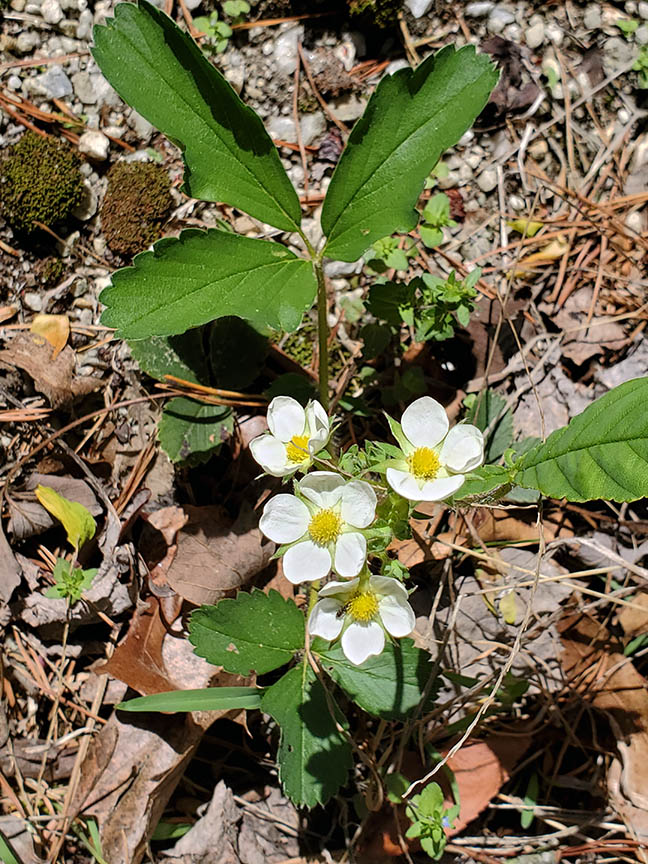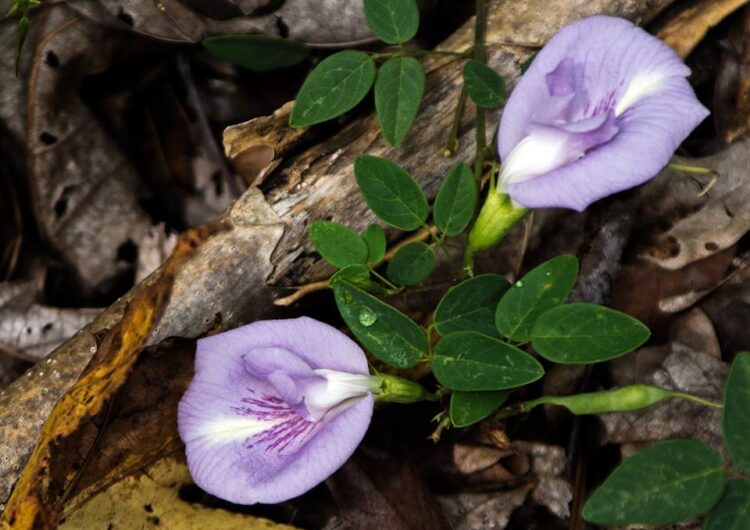
Pink lady’s slippers. Wild strawberries. Fire pinks. Along Farmville’s trailways, spring visitors can spot a variety of Virginia’s native plants peeking out in bright flashes of color. Many of these beauties are small and unassuming, so how can someone who’s not an avid gardener or wildflower enthusiast seek them out?
To get a better understanding of native plants in our area, we spoke with a local master gardener, Dr. Cynthia Wood. Cynthia is involved in the native plant movement, which started about 10-15 years ago due to declining populations of pollinators. Bees, wasps, and butterflies were losing their habitats because people were planting more and more non-native species. Simply put, Cynthia notes that “not every garden plant is equally pollinator friendly.” By protecting and preserving native plants, gardeners and conservationists hope to support pollinators and preserve Virginia’s natural ecosystem.
So how does Farmville fit in with the native plant movement? As a fringe area between southern and northern plants, Virginia has what Cynthia calls “the greatest diversity of native flowering plants of any state of its size.” (In fact in 2015, Virginia was found to have 3,200 species of flowering plants!) To catch a glimpse of some of these blooms, Cynthia suggests visiting four of our nearby state parks. As you walk, notice the shapes and colors of petals and the sizes of the leaves. Refer to our mini-guide below, which includes photographs by Cynthia herself. And bring out your inner botanist as you discover some of Farmville’s native plants.
High Bridge Trail State Park
An old railroad path, High Bridge Trail State Park runs right through the heart of downtown Farmville, extending on either side for a total of 31 miles. While the trail does have its share of non-native species (due to its history of heavy traffic), it is still home to a number of native plants and the most convenient place to explore Farmville’s plant culture. So grab a coffee or an ice cream cone from one of our downtown restaurants, and see if you can find some of these blossoms.

Passion Flower
Feel those tropical vibes! The gorgeous purple passion flower looks exotic but is native (and somewhat common) to Virginia. A wavy purple fringe layers purple petals. At about three-inches in diameter, the flower is the perfect size for larger bees and butterflies. According to the Virginia Native Plant Society, the passion flower has a rich history in Appalachia, having been used in Native American folk medicine as well as in southern home remedies for insomnia and anxiety.

Thimbleweed
The unique thimbleweed starts as a white, five-petaled flower and then morphs as a green, “thimble-like” fruit replaces the bloom. This prickly sphere of fruit remains on the plant until its seeds are blown away in the breeze.

Wild Strawberry
Virginia’s wild strawberries hug the ground in patches and clusters. Loved by bees, the white flowers arrive in bunches in May, giving rise to fruit in June—small but sweet!

Butterfly Pea
Common in dry, rocky woods, the twining vines of the butterfly pea grow up to two or three feet long, traipsing along the ground or encircling host plants. Concave (like a shallow bowl), the large, lavender flowers direct pollinators with dark purple lines leading to the center.
Twin Lakes State Park
Full of history, native bulrushes, and a number of colorful wildflowers, Twin Lakes State Park is well-loved in the area. At 548 acres, the park offers plenty of ground for the wildflower enthusiast to cover. You can choose from any of the seven trails (the two lake loops are some of the most popular). The Goodwin Lake Trail offers you a scenic mile-long walk, or for a longer hike, try Otter’s Path Trail, a three-mile loop around Prince Edward Lake. Watch the sides of the trail for these May buds.

Blue-Eyed Grass
At half a foot to a foot tall, blue-eyed grass (a member of the iris family) blooms in May and June and can be found in woods and meadows. Its narrow leaves resemble grass, and the blue flowers (which can sometimes seem violet) typically bloom in clumps.

Green and Gold
The creeping wildflower nicknamed “green and gold” spreads to form an attractive ground cover. Bright green, oval leaves frame the yellow flowers, which are known to be long-lasting.

Fire Pink
A favorite of hummingbirds, fire pinks are characterized by long, fiery-red petals with a tube at the center (perfect for those hummers) and thin leaves. These vivid blooms love roadsides, rocky slopes, and wooded areas.
Bear Creek Lake State Park
Tucked in the center of the Cumberland State Forest less than 20 miles from Farmville lies Bear Creek Lake State Park. Bear Creek has a number of trails under a mile long (easy to moderate strolls for those who just want a walk in the woods). Or, if you’d like to get lost in nature for a bit longer, check out the Channel Cat Loop or the Lost Barr Loop, each nearly two miles long. While you’re walking, keep an eye out for partridgeberry, an evergreen ground cover with fuzzy white flowers and bright red berries. You might see wild geraniums, which burst into blooms that range from light pink to purple, or Solomon’s seal, an upright, leafy stalk with whitish-green, bell-shaped flowers dangling underneath. But at Bear Creek Lake, Virginia’s native orchids are the stars.

Pink Lady’s Slipper
Bear Creek is home to one of Virginia’s twenty species of native orchids, pink lady’s slipper (a must-see in the area according to Cynthia), which blooms the first or second weekend in May. Pink lady’s slipper is a moccasin-shaped flower that can range in color from pale pink to magenta.

Putty-Root Orchid
You might also find the putty-root orchid, which produces a single stalk of yellowish-green flowers tipped with dark purple. This orchid may be more difficult to pick out of the spring cacophony of the forest floor, so look for its lone tiered stalk, which will stand at about a foot tall.
Holliday Lake State Park
Nestled in the Appomattox-Buckingham State Forest about a half hour’s drive from downtown Farmville, Holliday Lake State Park offers a number of short trails (all a mile or less). Holliday Lake’s one longer hike, the 6.5-mile Lakeshore Trail, hugs the shore for a beautiful lakeside walk. Many native plants can be found at Holliday Lake, including running cedar and Christmas fern (an evergreen whose tiny leaflets look like Christmas stockings). In fact, recently, a rare form of mountain mint, Torrey’s mountain-mint, was discovered here. Here are some of Cynthia’s top picks for Holliday Lake.

Showy Orchis
The purple and white ground orchid, showy orchis, is a stunner, though it grows less than a foot tall. The showy orchis has oval shaped leaves. Its stalk of white buds unfurl into a flower with a purple (or pink) “hood” petal and a white lower petal: the perfect runway for bumblebees!

Betony
Growing in colonies, wood betony sprouts multiple blooms at the top of its stem. The reddish-brown and yellow flowers are perfect for pollinators. In a past article, Cynthia shared that Native Americans used wood betony leaves “to fatten their horses and as a love potion.”

Skunk Cabbage breaks through the ice.

Skunk Cabbage Leaves
And how could we end without including the skunk cabbage? Don’t let the name deter you. This is Cynthia’s favorite native plant, so unique that it actually generates heat, pushing up through December’s ice and snow to bloom in the winter! If you stick a thermometer in a skunk cabbage, Cynthia says, it could be 20 degrees warmer than the air. Leafy skunk cabbages can be found in the spring at Holliday Lake State Park where they grow in swampy areas. In fact, one special spot has become what Cynthia calls a skunk cabbage nursery: “you’re walking, and you don’t see anything, and then you step on one and realize they’re everywhere.”
So what is Cynthia’s biggest advice for visitors interested in Farmvile’s native plants? “Just to get out and look.” Explore. Take friends or family. If kids are with you, start simply by identifying common plants like dandelions (though these aren’t native—they’ve been around the area since the 1600s).
Find a plant you can’t identify? Download the Seek app by iNaturalist, which analyzes a snapshot from your phone’s camera. Or check out the Flora of Virginia app where you can browse drawings, plant descriptions, and maps for individual Virginia species. The Digital Atlas of Virginia Flora is one of the best resources, found online at vaplantatlas.org. Or simply join Cynthia’s Facebook community page, “Virginia Wildflowers,” a group dedicated to sharing a love of Virginia’s native blooms. Hey, maybe you’ll even get some identification help from the master gardener herself! Happy exploring.
